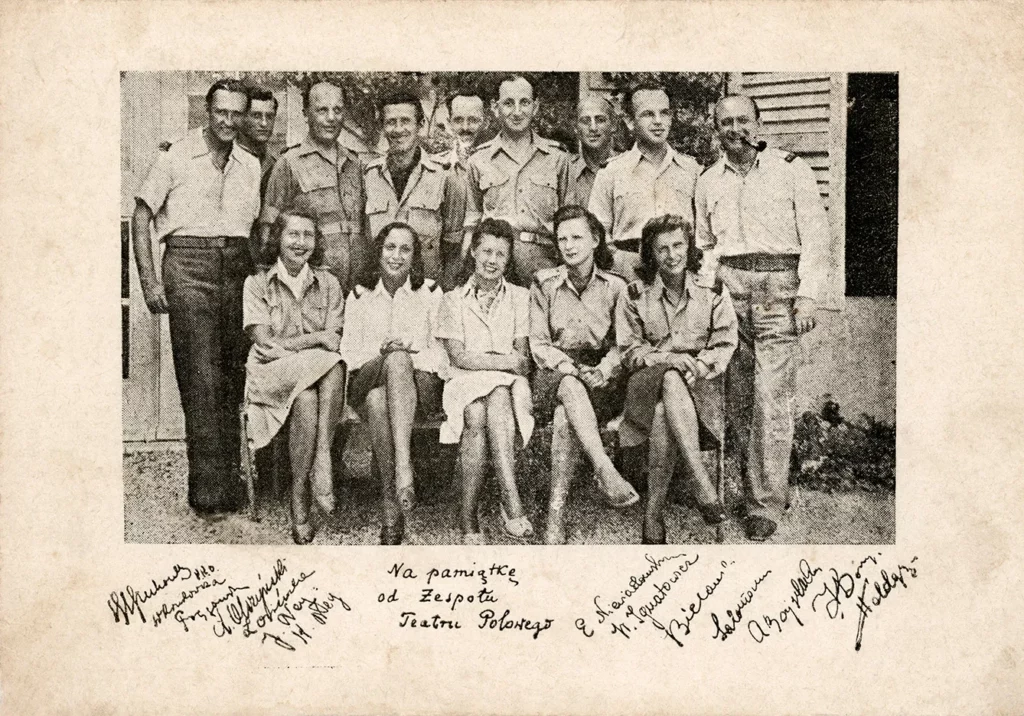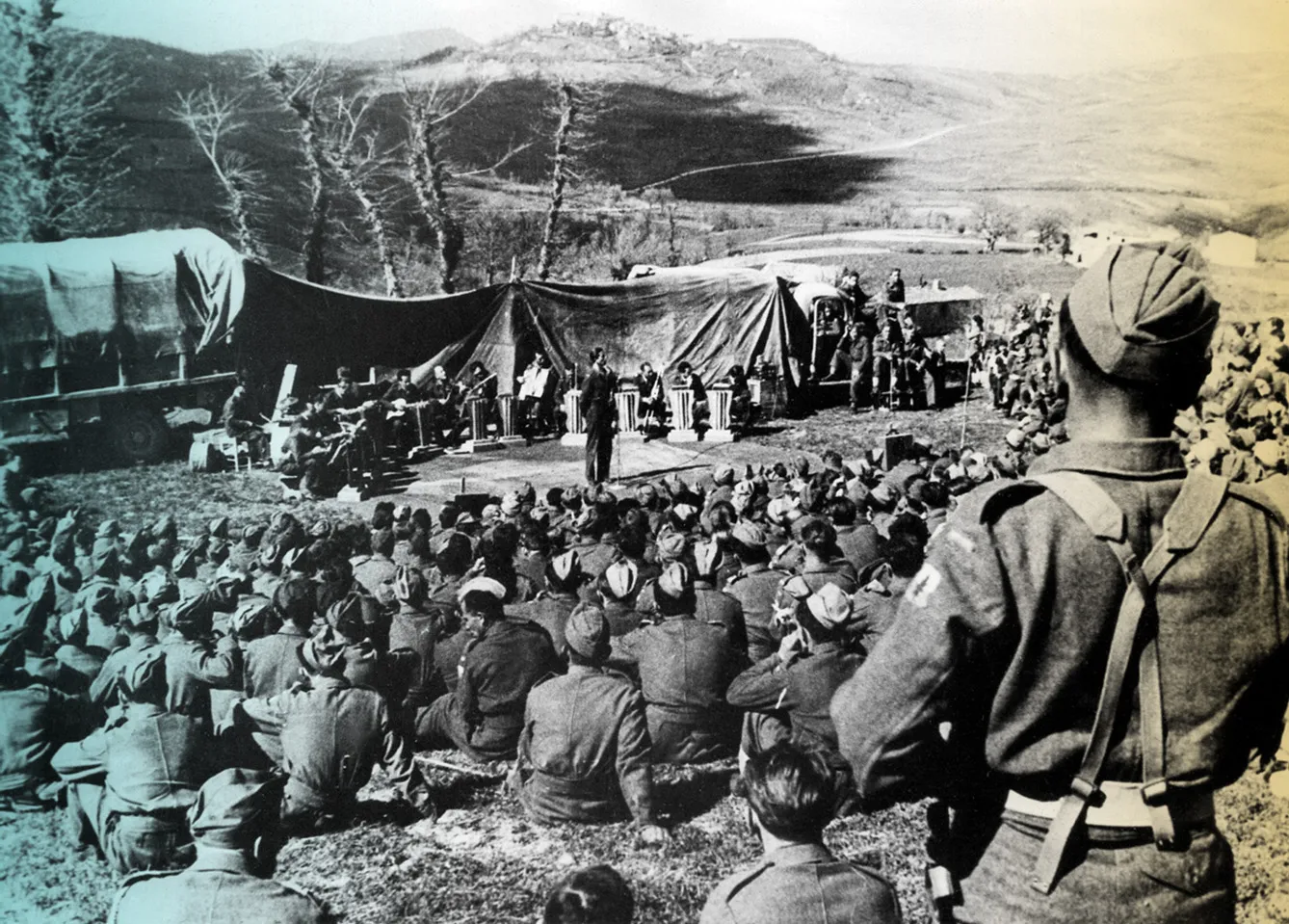The Second World War, to be precise. The idea goes against the words once uttered by Cicero, who said, Inter arma silent Musae (In times of war, the Muses fall silent). Not that it was a particularly true maxim; thus, it should be understood metaphorically, especially since arts have always been present alongside warfare, including in antiquity. Considering that performing arts right near the frontlines poses a serious challenge, it is more interesting to learn how some of such enterprises proved to be successful and artistically comparable to shows staged at professional theatres during peace.
What comes next?
One of the most troubling questions to artists touched by the horrors of war is, “What comes after?” When peace finally prevails, and soldiers lay down their arms, day-to-day life must be reconstructed. And with life comes art.
During the Second World War in Poland, various artistic groups formed in defiance of the occupier aimed at keeping the nation’s spirit alive and bringing hope. Karol Wotyła, later Pope John Paul II, was famously involved in such conspiratorial artistic performances. But among numerous theatrical groups and artistic initiatives formed during the war, one was particularly unique and took Polish theatre far across the borders, over the seas, to the dunes, heat, and scorching sun: the Polish II Corps Theater.
Aiming high
The Polish II Corps Theater was different from other similar groups. Its goal was to present soldiers with real-deal shows rather than revue-format performances. The latter was considered to be the lesser evil in a reality where everything – from scripts to decorations to professional actors – was hard to come by.




One of the critics, Zdzisław Broncel, expressed, “It seems fit to aspire to uphold [Polish theatrical traditions]. Is such an approach one that is aiming too high? Is this expecting too much from a carefree, military revue? I believe not. I am convinced that to the contrary – having more pressing demands towards the shows shall manifest fondness expressed in renouncing this particular tolerance of various shortcomings. Higher expectations will surely be followed – knowing the ambition and talent burning in the hearts of our fellow actors – by the cast’s development.” The future artistic director of the Polish II Corps Theatre, Wacław Radulski, shared this point of view. When he tied the fate of his cast to that of the Anders’ Army (the common name of the Polish II Corps), he expected quality. And quality he delivered.
Stars, camels, and thousands watching
It was the artists who took the initiative to start the Polish II Corps Theater. It was formally established on 1 April 1943 in Baghdad. Why in Baghdad?
When caught, many Polish artists, especially those involved in the conspiracy against the enemy, were sent to Siberia to serve sentences in Russian gulags. In 1941, several of them were released thanks to Polish political efforts. Wacław Radulski and Jadwiga Domańska – the Polish II Corps Theater leaders – were among the released prisoners. The group members were assigned to the Polish II Corps (thus being classed as soldiers) and evacuated with the troops from the USSR territory to the East. And that’s when the art of theatre started working its magic.
It might be hard to imagine how such tired, gravely experienced people could create a theater from nothing. But that’s precisely what they did. They did not settle for low quality. During the five years of continuous artistic activity, they performed over 25 plays giving more than 650 shows, and were watched by over 300,000 spectators.
And it wasn’t just soldiers coming to see their performances. Word of mouth spread, and thousands of locals came to see their plays alongside Polish, British, and Hindu soldiers. They made the costumes and scenography as they would in a regular theater and made do with whatever was around.
Wouldn’t you like to watch the stage production of One Thousand and One Nights in your native language (or some oriental language from lands not known), sitting in the desert under the starry sky? Or enjoy a Nativity Scene show with the Three Wisemen arriving on real camels in their natural habitat? The actors took their mission to heart to cultivate Polish theatrical thought. So much so that when the Polish II Corps relocated to Italy, one of the four supply planes was just filled with decorations, costumes, and other artistic gear!
Under live fire
The group’s activities can be divided into Eastern and Italian periods. The most memorable performances included “Tu jest Polska” [This Here is Poland] by Naglerowa; “Scaping the Schemer” by Moliere; “Zemsta” [The Revenge] by Fredro; “Wesele na Górnym Śląsku” [A Wedding in Upper Silesia] by Ligoń; “Much Ado About Nothing” by Shakespeare, and “Wesele” [The Wedding] by Wyspiański.
Not many people know that a famous Polish military song, popular to this day, “Czerwone maki na Monte Cassino” [The Red Poppies of Monte Cassino], was first performed by Gwidon Borucki (aka Guido Lorraine) and his then-wife, Irena (who later married General Anders. Seems like love always finds a way, even in times of struggle) just two days after the battle finished.
Members of the group who were present at that time on the front were awarded the Monte Cassino Commemorative Cross. But the actors were accompanying the troops to also provide the soldiers and locals with moments of laughter among the tears and struggle. Such was the case during the spectacle of one of the Polish comedies by Fredro, “Damy i Huzary” [Dames and Hussars]. As recollected by one of the actors, Hugon Krzycki, when the famous line “Gregory, fire the mortar!” was uttered, it was accompanied by “a mortar fire no theatre has ever experienced. An original anti-aircraft 75 cannon was fired. Of course, the impression was monumental; however, the cannon stood too close to the scene. The gust of air knocked half of the decorations down, and the actors got buried under the sand. It took half an hour to put everything straight. The audience was raging.”
Final stop – the UK
The group was active for five years. The last play, “Wesele” by Wyspiański, was staged in the UK in 1948. The incredible journey of the acting group took them from the USSR to Great Britain via today’s Iran, Iraq, Palestine, Egypt, and Italy. Their mission was no less hard and risky than that of the soldiers, yet they showed bravery and perseverance in doing what they did best – evoking positive emotions in the hearts of, in this case, the audience traumatized by the acts of war they witnessed and had to take part in.
The fact the memory of this extraordinary theater survived, despite its members never performing in front of their native audience, testifies to the fact they succeeded at touching the hearts of those who, among the insanity of warfare, were able to, for a second and thanks to their performances, remember the world they were fighting for more clearly.







